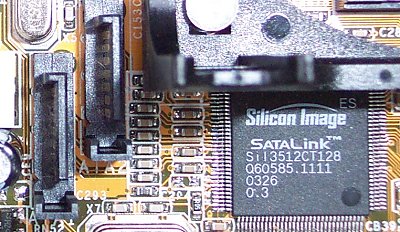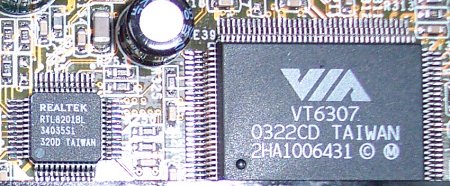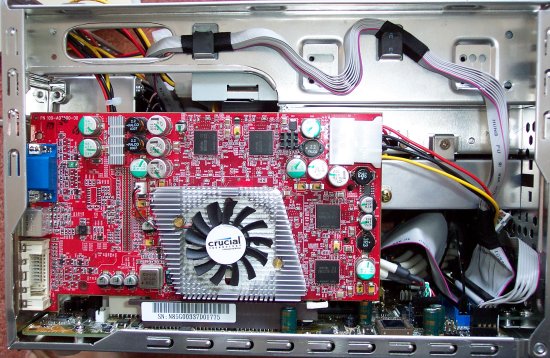Layout, cooling and looks
With a retention bracket surrounding the ZIF socket you'd be forgiven for thinking this was a P4-based XPC. The new Clawhammer (Socket-754) and Sledgehammer (Socket-940) CPUs now use integrated heatspreaders and retention brackets, much like Intel. Because the nForce3 150 is so bereft of on-chip goodness, Shuttle has had to include a number of PCI-based controllers to give this cube the functionality of others in the range.


Straddling the retention bracket on two sides are two such controllers and a physical layer. No on-chip SATA support has translated into a Silicon Image Sil3512CT128 PCI-based controller with two associated ports. Marvell could have been employed for bridge work, but Shuttle felt that RAIDable SATA (where would you fit the second drive if you're keeping the card reader ?) was the way to go. Much like the Sil3112A, the '3512 offers independent, RAID0, RAID1 and JBOD support. SATA makes implicit sense in a small form factor PC. The thin cables help keep airflow running smoothly.
Realtek's RTL8201BL physical layer provides the conduit for NVIDIA's on-chip LAN, and VIA's VT6307 2-port FireWire single-chip controller provides for the 2 FireWire ports present on the front and back. The nForce3 150 does provide for in-built USB2.0 support. Shuttle manages to use up 4 of 6 possible ports. The wonderful NVIDIA APU was also axed in the transition from nForce2 to nForce3. Realtek's ALC650 CODEC provides only reasonable 6-channel sound. Why oh why, NVIDIA ?.
Shuttle has been using its I.C.E (Integrated Cooling Engine) cooling on a number of XPCs now. The small confines of the case and a wealth of components and peripherals demands efficient, space-saving cooling. Shuttle's engineers seem to have improved the I.C.E over time.


A chunky cooler that's driven by heatpipe technology. The aluminium base of the cooler contains a measure of liquid. As the processor becomes warmer and warmer the liquid begins to absorbs the heat. The hot liquid begins to turn to vapour and runs off to the cool end of the heatsink, through the 4 pipes above, which is in turn cooled by a variable-speed fan. The cooler vapour then changes back to liquid form and makes its way back down to the base, ready to absorb the CPU's heat again. The basic fact is that Shuttle would have a hard time cooling the heatsink's base in any instance. A heatpipe is an imaginative and useful addition. We're just a little perplexed as to why Shuttle chose to forego the standard copper-bottomed I.C.E cooler found on other models. Incidentally, the reviewing sample arrived with an Athlon 64 3200+ in the socket, probably due to the lack of supply. Don't expect such generousity in full retail form.


The clip, shown above, is used to secure the heatsink to the CPU. There's enough pressure to ensure that a decent imprint is left over from the interaction of the cooler's base, thermal material and the CPU. AMD has now adopted an integrated heatspreader into its newest designs. No more chipped, bruised or battered cores. That should inspire even novice users to have a go at a self-build. There's very little that can go wrong if a little time and patience is exercised.
It's nice to see Shuttle continue to pay attention to detail. The Sunon fan slides over the upper portion of the heatsink to provide the necessary airflow required to cool the heatpipe. The aluminium housing now sports four rubber washers that should help limit the unwanted side-effect of internal case vibrations. The fan can be run at a multitude of speeds, all configurable from within a handy and powerful BIOS.

After what seemed like an age but was only 30 minutes or so, the Shuttle SN85G4 began to take shape. The most difficult part of building into an XPC, and especially this one, is knowing and understanding the best order of placing components inside the chassis. For example, placing the AGP card in before the fan precludes one from adding the fan's power connector on to the motherboard. Similarly, all IDE cables should ideally be inserted before the drive cage is positioned back in place. Shuttle provides 3 molex connectors, 2 floppy-style connectors and a single SATA power cable. The molex connectors cannot simultaneously connect to a drive and, say, the 9800 PRO graphics card; the cables are just too short. A molex extender had to be recruited, something that didn't help internal airflow.

It's only after construction do you realise just how potent the SN85G4 can be. There's no reason, barring wallet failure, that one couldn't have an ATi 9800 PRO, 250GB SATA drive, 1GB of high-speed memory, discrete 24-bit sound card and a multi-format DVD/CD ReWriter. Add in a sexy TFT and be considered cool not geeky.









